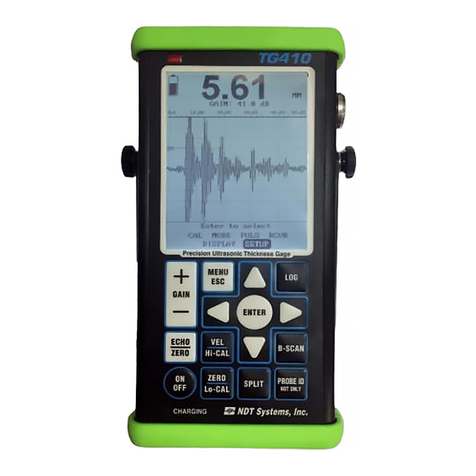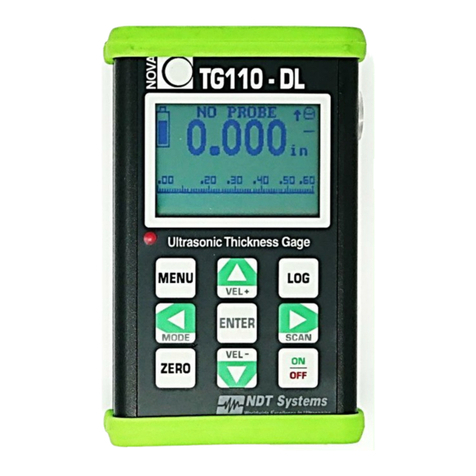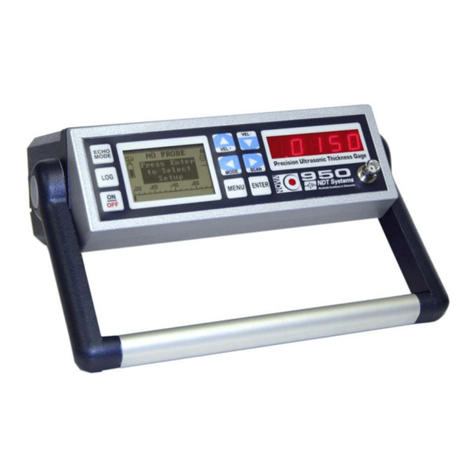
Manual No. OM5000
Jan X/04 Ver 1.40 vi
LIMITED WARRANTY
1. WARRANTY: NDT Systems, Inc. warrants that reasonable care was used in the choice of materials and the
manufacture of this instrument, and that the instrument conforms to the published ratings and characteristics
applicable to the instrument at the time the instrument is shipped to the Buyer. This warranty shall extend for a period
of one year from the date of shipment of the instrument (FOB Seller's plant) and shall in no event extend beyond such
term. The Buyer shall notify NDT Systems, Inc. within the time and in the manner specified herein shall constitute a
waiver of any such claim of defect or breach of warranty. The final determination of the existence of a defect or breach
of this warranty shall be made by NDT Systems, Inc. This warranty shall extend to the buyer only, and shall not be
assignable or transferable to any other person.
2. DISCLAIMER OF WARRANTIES THERE ARE NO WARRANTIES, EXPRESS OR IMPLIED, INCLUDING ANY
IMPLIED WARRANTY OF MERCHANTABILITY OR FITNESS FOR A PARTICULAR PURPOSE, OTHER THAN
THOSE WARRANTIES SET FORTH IN THE PARAGRAPH ENTITLED "WARRANTY" ABOVE.
The above warranty shall not apply to digital panel meters and items with a limited life, such as batteries,
probes or cables, nor to any instruments which have been subjected to misuse, improper installation or repair,
alteration, or use beyond the published rating of the instrument.
3. BUYER'S REMEDIES: The Buyer's sole exclusive remedy for breach of the above warranty shall be the repair or
replacement of the instrument by NDT Systems, Inc., free of charge. The Buyer shall return the instrument to NDT
Systems, Inc., transportation prepaid. NDT Systems, Inc. shall promptly repair or replace the instrument and return
same to Buyer, FOB Seller's Plant, collect.
If, for any reason, NDT Systems, Inc. is unable or unwilling to repair or replace the instrument or, because of
circumstances, the exclusive remedy provided herein fails of its essential purpose, or operates to deprive either party
of the substantial value of its bargain, then the Purchaser's exclusive remedy will be the return of the purchase price
for the instrument. The liability of NDT Systems, Inc. shall in no event be greater than the full amount of the purchase
price for the instrument.
Any attempt by NDT Systems, Inc. to repair or replace any instrument sold hereunder shall not constitute an
admission that the instrument, or any part thereof, is defective within the meaning of the above warranty, nor that NDT
Systems, Inc. has any legal responsibility to make such repair or effect such replacement.
Any such attempts, if unsuccessful, shall not create any liability on the part of NDT Systems, Inc. and the
purchaser is limited to the remedy set forth herein.
4. LIMITATION ON LIABILITY: NDT Systems, Inc. shall not, under any circumstances, be liable for direct, incidental
or consequential damages for any breach of contract, breach of warranty or misrepresentations, including the
negligence of NDT Systems, Inc., including, but not limited to, damages resulting directly or indirectly from the use, or
loss of use, of the instrument sold hereunder, or the business of the Buyer or third persons wherein the instrument is
utilized.
The above warranty, and the obligations of NDT Systems, Inc. hereunder, are expressly in lieu of, and the
Buyer expressly waives, any other liability of NDT Systems, Inc. based upon warranty, express or implied, contract, or
the negligence of NDT Systems, Inc., including, but not limited to, negligence in the design of the instrument or in the
choice of the materials therefor, or negligence in the repair or replacement of the instrument, whether such repair or
replacement is required by the terms hereof or is voluntary, upon the part of NDT Systems, Inc.
Except as provided herein, no person is authorized to assume on behalf of NDT Systems, Inc. any other or
additional liability or responsibility in connection with the instrument. These terms and warranty are applicable to and
part of all quotations, sales and transactions with the Buyer, and by placement of a purchase order, Buyer signifies
complete acceptance of such a binding legal agreement.































